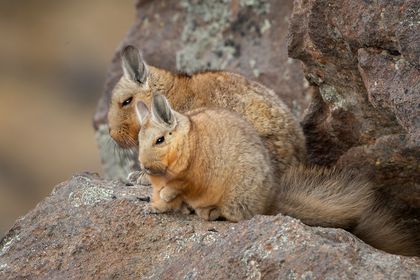Imagine a feathery-tailed, round rabbit-like creature munching on grasses in the mountains of Patagonia. This is Wolffsohn’s Viscacha Lagidium wolffsohni, and despite possessing long, rabbity ears, viscachas are actually rodents, most closely related to chinchillas.

Wolffsohn’s Viscacha: Dario Podesta
There are five extant species of viscacha, all native to South America. Wolffsohn’s Viscacha – officially described in 1907 after J.A. Wolffsohn donated several specimens to the British Museum – is known from the Sierra de los Baguales mountain range crossing southern Argentina and Chile. Viscachas are found across a variety of elevations, favouring rocky cliffs and outcrops. As zoologist Pearson (1948) once put it: “no rocks, no viscachas”.
Wolffsohn’s Viscachas prefer very steep areas where they have been observed living in colonies and reproducing only once annually (or potentially even less). However, not much else is known about this species. On the IUCN Red List, it remains categorised as Data Deficient.
Between a rock and a hard place
Being listed as Data Deficient does not mean that Wolffsohn’s Viscachas are without threat. This species was historically hunted for fur and food by the first inhabitants of Patagonia, and may still be occasionally hunted today. It could also be vulnerable to climate change and the associated impacts upon habitat availability. Other species of viscacha, such as the Southern Viscacha Lagidium viscacia, are reported to be threatened by disturbance, habitat loss and fragmentation, and some colonies are nowadays restricted to isolated patches.
Quantifying the threats and population trends of Wolffsohn’s Viscachas will be key to updating and understanding the conservation status of this species. This is a knowledge gap that one of the SMSG’s newest members, Morgan Pendaries, is hoping to fill. Morgan is working on a PhD project that will gather ecology, demographic and threat data of Wolffsohn’s Viscacha.

Working with Wolffsohn’s Viscacha. Left: Morgan Pendaries. Middle, right: Gonzalo Pardo.
Conducting the research alongside Programa Patagonia, Morgan has been carrying out viscacha surveys since 2018. “What I really enjoy about the work after 5 years of study is going to the field and observing the viscachas,” Morgan says. “They are such a gorgeous and curious species that I’m always really happy to just observe them.”
The work involves capture-mark-recapture surveys as well as efforts to gather data on the social dynamics of a colony, habitat use and interactions with other wildlife. Interviews with local people are also an important element – Morgan and the team want to learn more about viscachas using local knowledge, but also understand public perceptions of these animals.
Morgan’s work will ultimately help to inform the Red List reassessment of Wolffsohn’s Viscacha and, if needed, drive conservation plans forward for this species. In the meantime, we are looking forward to reading any future research updates on this unusual, rabbity rodent!
If you’d like to learn more about the project and Programa Patagonia’s work in general, check out their Instagram page here: https://www.instagram.com/programapatagonia/.
Author: Abi Gazzard (SMSG Programme Officer)




